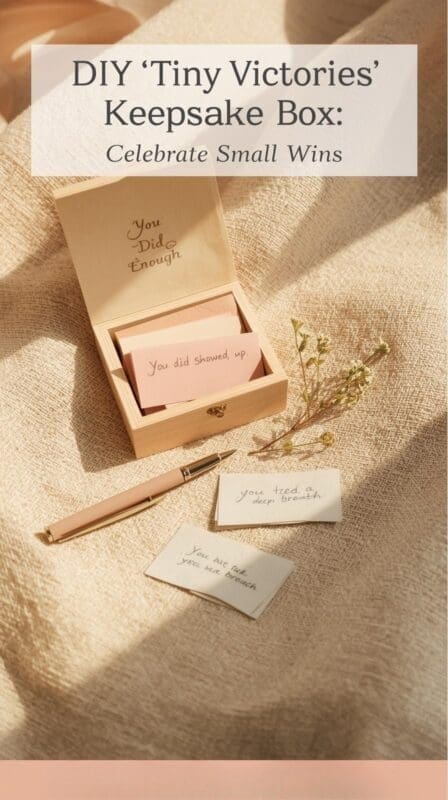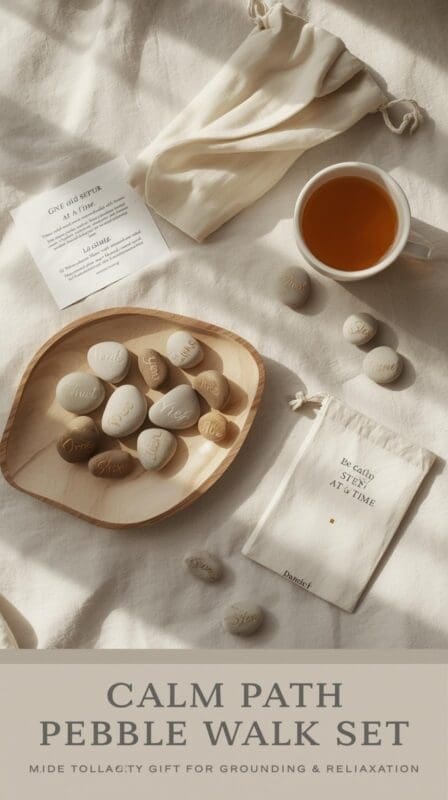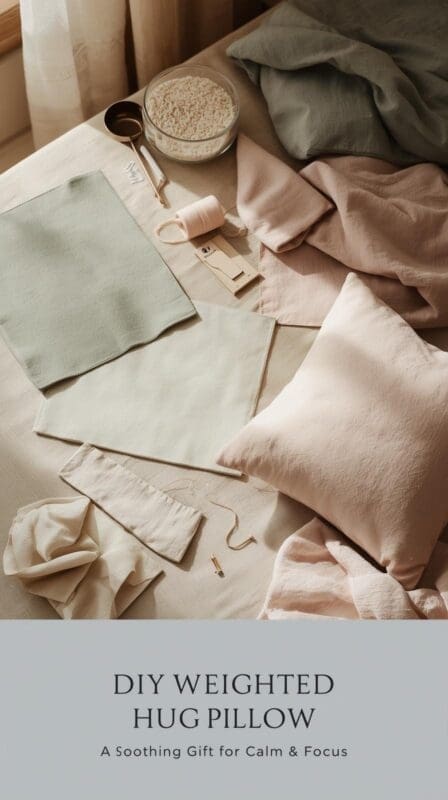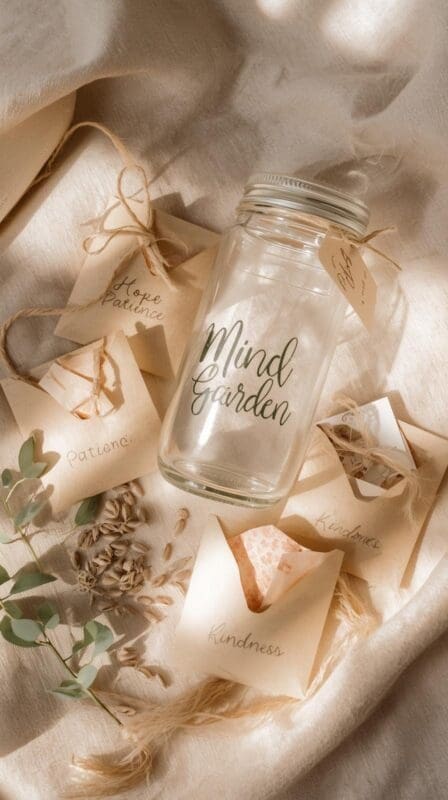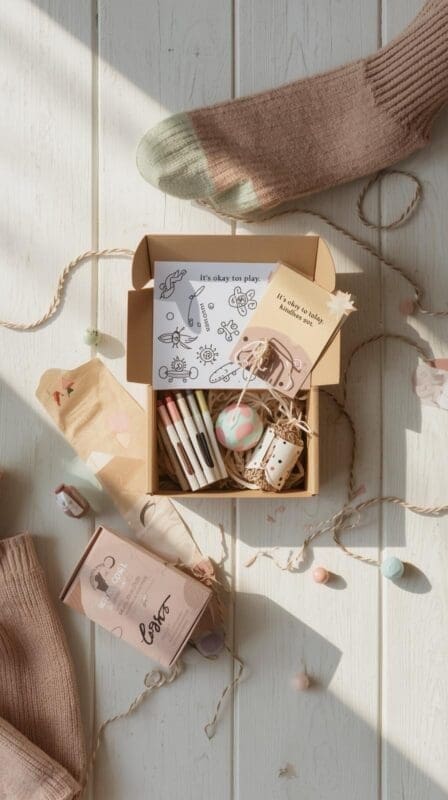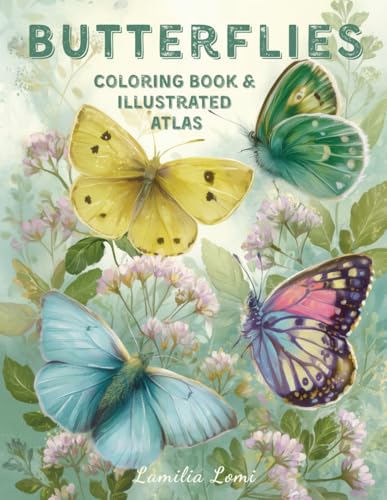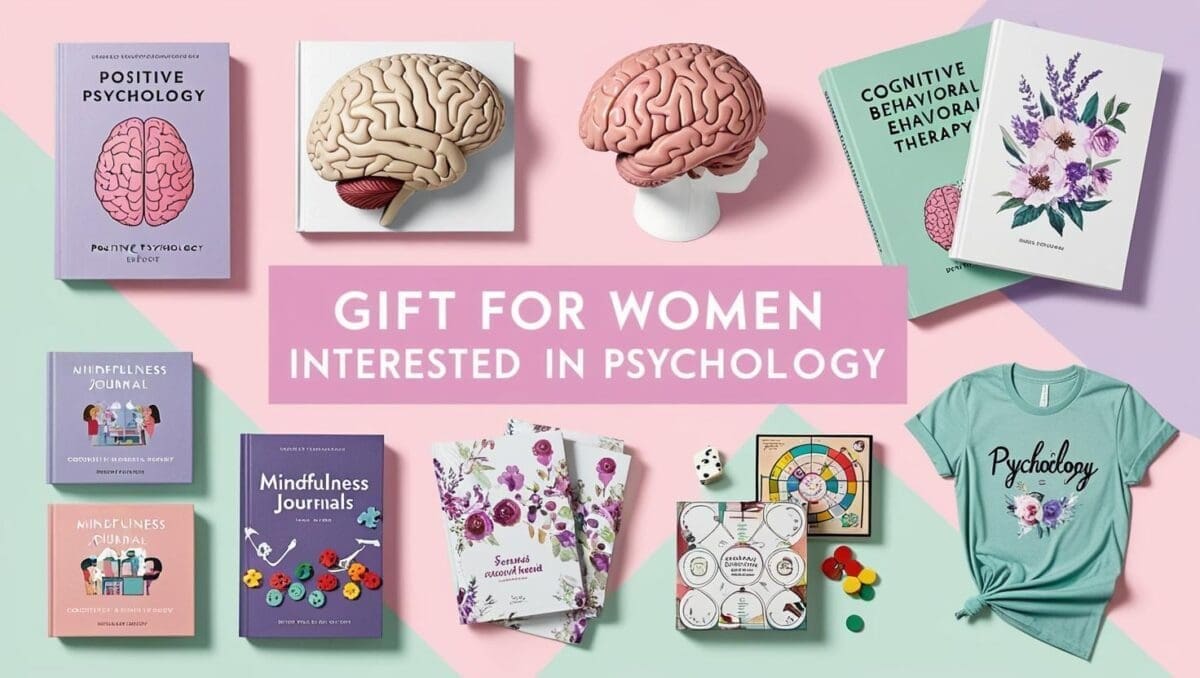Some gifts are wrapped in paper. Others are wrapped in intention. In a season that often feels loud, handmade, mindful gifts become a quiet kind of care.
Affiliate Disclosure: This post may contain affiliate links. If you purchase through a link, I may earn a small commission at no extra cost to you. Thank you for supporting my counselor-created resources.
A Small Story About Big Calm
Late on a snowy Friday, I slipped a hand-poured candle into a colleague’s palm after a week that felt heavy for both of us. The room still carried the day’s echoes—soft closes of office doors, the hum of the heater, the cinnamon of someone’s tea. She exhaled, the long kind, and smiled without speaking. In that moment I was reminded: the best gifts don’t just decorate a space—they regulate a nervous system.
That’s why I come back to mindful, handmade gifts each December. They’re calming to make, grounding to give, and easy to adapt for therapy offices, classrooms, or cozy living rooms. In this guide, you’ll find DIY Christmas gifts that are affordable, sensory-wise, and evidence-informed—each with simple materials, step-by-step instructions, and a short note on why the project helps. Think counselor/OT voice: practical, safe, and gentle.
Promise: You’ll leave with 10 detailed “pattern cards,” inclusive safety notes, quick cost/time planning, and a few rituals that make the gifting moment feel like a mini intervention in itself.
Why Mindful Handmade Gifts Work
Mindful gifting is more than craft time—it’s co-regulation in a bow.
- OT lens (sensory-motor): Hands shaping clay, measuring wax, smoothing fabric—these rhythmic, tactile motions down-regulate arousal. Repetitive bilateral actions (stir, pour, fold) help the body find a calmer baseline.
- Tactile + scent = grounding: Touch engages the somatosensory system; gentle scents (or scent-free choices) can anchor breath.
- Tiny science note: Novelty + making releases little pulses of dopamine (motivation/interest), while ritual (lighting a candle, reading a card, a breath before giving) supports vagal tone—our body’s calm-down pathway.
- Therapist reflection: Intention beats perfection. Uneven edges and hand-lettered tags communicate presence: “I made this for you.”
When our gifts model mindfulness and accessibility, we’re not just handing over an object—we’re offering a small, repeatable way to feel better.
The Projects
Each project includes: Materials • Time & Difficulty • Steps • Therapeutic/SEL Benefit • Safety & Accessibility • Bundle it with… • Optional Tag Text
1) “Tiny Victories” Keepsake Box
What it is: A decorated box filled with pre-written slips celebrating small wins—an antidote to all-or-nothing thinking.
Materials: Small wooden/cardboard box; washi tape or paint pen; 10–20 paper slips; ribbon or twine.
Time & Difficulty: 20–30 min • Beginner.
Steps:
- Decorate the lid with a phrase (“You did enough.”).
- Write 10–20 slips (“You showed up.” “You took a breath.”).
- Tuck extra blanks inside for the receiver to add weekly wins.
- Tie with twine.
Therapeutic/SEL Benefit (counselor lens): Turns cognitive reframing into a tangible ritual; builds self-efficacy through micro-acknowledgments.
Safety & Accessibility: Use non-glass boxes for schools; large-print slips for low-vision; avoid glitter for sensory-sensitive folks.
Bundle it with…: Fine-tip pen + small notepad.
Tag Text: “For every step you take—even the tiny ones.”
- This wooden keepsake box features a beautiful Tree of Life Engraving With Flame Work painted finish to give a vintage fe…
- Create the perfect and unique vintage gift box. Be the perfect birthday, engagement or housewarming gift.
- Also can be used to keep precious stones, watches, tarot cards, herbs, Feng shui items and add a touch of class to your …
2) “Calm Path” Pebble Walk Set
What it is: Smooth stones labeled with grounding words (“Breathe,” “Trust,” “Release”) in a pouch or shallow tray.
Materials: 8–12 smooth pebbles; paint pens/metallic marker; linen pouch or shallow dish.
Time & Difficulty: 25 min • Beginner.
Steps:
- Wash/dry pebbles.
- Letter one word per stone.
- Place in pouch or line in tray as a mini “walk.”
- Add brief instruction card.
Therapeutic/SEL Benefit (OT lens): Tactile sequencing + visual cues = paced breathing and interoceptive awareness.
Safety & Accessibility: Not for mouthing stage; use wood discs for child-safe version; skip scented finishes.
Bundle it with…: Tea + a 1-minute breathing card.
Tag Text: “One calm step at a time.”
3) DIY Weighted “Hug Pillow”
What it is: A soft lap pillow (rice/flaxseed) for grounding during reading, meetings, or sessions.
Materials: Soft cotton/minky fabric; rice/flaxseed; thread/needle or machine; funnel.
Time & Difficulty: 35–45 min • Confident beginner.
Steps:
- Cut two rectangles (e.g., 25 × 35 cm).
- Sew three sides; flip; fill evenly (0.7–1.2 kg).
- Top-stitch to close; add channels if desired for weight distribution.
Therapeutic/SEL Benefit: Deep pressure input calms the nervous system and supports sustained attention.
Safety & Accessibility: Make removable, washable cover; avoid too heavy for children; label contents for allergy transparency.
Bundle it with…: Lavender-free sachet (unscented option) + journal.
Tag Text: “A hug you can keep on your lap.”
4) “Mind Garden” Seed Jar
What it is: Mini seed envelopes paired with gentle intentions and prompts.
Materials: Small jar/tin; kraft paper for envelopes; seeds (wildflower/herb); mini cards.
Time & Difficulty: 20–30 min • Beginner.
Steps:
- Fold tiny envelopes; add a few seeds.
- Label: “Hope,” “Patience,” “Kindness.”
- Add a prompt card (e.g., “What are you nurturing this season?”).
- Pack in jar.
Therapeutic/SEL Benefit: Metaphor + growth encourage future orientation and self-compassion.
Safety & Accessibility: Use paper envelopes for schools; confirm seed safety with pets/children; offer soil-free “paper plant” option.
Bundle it with…: Small terracotta pot or mini frame for the prompt.
Tag Text: “Plant what you want to keep.”
5) Clay “Breathe” Diffuser Pendant/Keyring
What it is: Air-dry clay charm that absorbs a drop of essential oil (or stays unscented).
Materials: Air-dry clay; letter stamps/skewer; jump ring or cord; optional EO (lavender/bergamot).
Time & Difficulty: 30–40 min + dry time • Beginner.
Steps:
- Form discs; stamp “Breathe/Calm/Here.”
- Poke hole for ring/cord; dry fully.
- Thread and package; include scent-free note.
Therapeutic/SEL Benefit: Tactile cue for breath; optional scent supports interoception and mindful pause.
Safety & Accessibility: Provide unscented by default; EO patch test note; avoid for pregnancy/airway sensitivity.
Bundle it with…: Card with a 4-4-6 breath pattern.
Tag Text: “Touch here. Inhale gently. You’re back.”
6) “Letter to Future Me” Reflection Kit
What it is: Guided stationery set for a letter opened next Christmas/New Year.
Materials: Envelopes; quality paper; guide card with 6 prompts; washi seal.
Time & Difficulty: 15–20 min • Beginner.
Steps:
- Print/copy prompts (boundaries, joy, support).
- Bundle paper + envelope + guide.
- Add “Open on: [date]” sticker.
Therapeutic/SEL Benefit: Builds continuity, hope, and self-attunement; supports goal scaffolding.
Safety & Accessibility: Provide large-print and neuro-affirming prompts; gender-neutral language.
Bundle it with…: Fine-liner pen + tea.
Tag Text: “A gentle note from you—to you.”
7) “Sound of Calm” Playlist Jar (QR Edition)
What it is: A jar of cards with QR codes to calming music/meditations (your curated links).
Materials: Small jar; cardstock; printed QR codes; string.
Time & Difficulty: 20–25 min • Beginner.
Steps:
- Generate QR codes for playlists/meditations you trust.
- Print/trim cards; tie a few with string.
- Add a note: “Scan when your breath feels short.”
Therapeutic/SEL Benefit: Blends tech cues + tactile ritual; supports quick access to regulation tools.
Safety & Accessibility: Use ad-free links where possible; include headphones note for sensory control.
Bundle it with…: Budget earbuds or a small stand for the jar.
Tag Text: “Break-glass-in-case-of-overwhelm (just scan).”
8) “Inner Child” Holiday Kit
What it is: A playful box inviting rest and small joy.
Materials: Mini coloring booklet; unscented markers/crayons; tiny nostalgic toy (yo-yo/bubbles/putty); kindness card.
Time & Difficulty: 15–25 min • Beginner.
Steps:
- Assemble 3–4 items in a small box/tin.
- Add card: “It’s okay to play. It’s okay to rest.”
- Wrap simply.
Therapeutic/SEL Benefit: Play reduces perfectionism and supports self-soothing; normalizes joy for adults.
Safety & Accessibility: Avoid latex balloons; choose quiet fidgets; ensure non-toxic supplies.
Bundle it with…: Soft socks or cocoa packet.
Tag Text: “Permission to play, granted.”
9) “Reframing” Soy Candle with Hidden Note
What it is: Hand-poured candle; as it burns, a tiny foil-wrapped message appears (“You are enough.”).
Materials: Soy wax; cotton wicks; tin/metal container (school-safe); heat-safe pitcher; tiny note + foil.
Time & Difficulty: 40–60 min • Intermediate (hot wax safety).
Steps:
- Melt wax per instructions; set wick in tin.
- Wrap note in foil, affix near wick base.
- Pour wax; cure fully; label with burn safety.
Therapeutic/SEL Benefit: Ritual + light = paced unwinding; message reinforces self-compassion.
Safety & Accessibility: Use tins (no glass for schools); scent-free option; clear burn warnings.
Bundle it with…: Ceramic match striker or breath card.
Tag Text: “A slow light for slow days.”
10) “52 Moments of Stillness” Card Deck
What it is: A deck of 52 prompts for micro-mindfulness and kindness.
Materials: Cardstock; corner rounder (optional); ring clip/box; gold/ink pen.
Time & Difficulty: 45–60 min • Beginner.
Steps:
- Write 52 prompts (1-minute snow watch, gratitude text, body scan).
- Number and bundle with ring or in a box.
- Add “one per week” guide.
Therapeutic/SEL Benefit: Builds habit stacks of regulation; teaches interoception and social connection.
Safety & Accessibility: Include screen-free and movement-optional prompts; culturally neutral language.
Bundle it with…: Small stand to display a weekly card.
Tag Text: “A year of tiny pauses.”
Mindful Gifting Rituals (make the moment therapeutic)
- 30-second breath before giving: Inhale 4, hold 2, exhale 6. Soften your shoulders. Place your hand on your heart, then the gift.
- Speak the intention: One sentence: “I hope this brings you calm on the days that ask a lot.”
- Eye contact + pause: Let the moment land.
- Invite a micro-ritual: “Light this when you journal,” “Pull one card on Mondays,” “Touch the pendant before you start.”
These tiny choices shift gifting from transaction to attunement.
Make It Inclusive, Safe, and Trauma-Sensitive
- Fragrance-free by default: Offer unscented versions; if using essential oils, include patch-test guidance and clear labeling.
- Skip glitter: Many therapy/school spaces avoid glitter (sensory + clean-up). Use mica powder, matte paint, or paper confetti as alternatives.
- Latex-free + non-glass: Choose latex-free elastics and metal tins instead of glass for classrooms/clinics.
- Cultural sensitivity: Prefer neutral winter palettes (soft whites, pine, navy, gold) and nature motifs over holiday-specific icons to honor diverse traditions.
- Accessibility: Large-print cards, dyslexia-friendly fonts, high-contrast tags; avoid sound-trigger items; offer seated/low-fine-motor adaptations.
Gift Tags & Printables (ready-to-use one-liners)
- “For the days that need a softer edge.”
- “You don’t have to do it all to be enough.”
- “A tiny pause for your very big heart.”
- “May this help you breathe between the lines.”
- “You are allowed to rest.”
- “One gentle step at a time.”
(Feel free to handwrite or print on kraft tags; add the breath pattern 4–2–6 on the back.)
Cost & Time Planner (pick fast)
| Budget / Time | 10–15 min | 30–45 min | 60+ min |
|---|---|---|---|
| Under €10 | Stickered “Tiny Victories” slips in envelope; Inner Child mini kit | Pebble set; Letter to Future Me kit | 52-card deck (DIY cardstock) |
| €10–€20 | Zipper-pouch Inner Child kit | Weighted hug pillow (cover only); Seed jar | Candle in tin (unscented) |
| €20–€40 | Framed prompt with small card pack | Soy candle + striker bundle | Larger hug pillow + journal bundle |
(Costs vary by what you already have; reuse and upcycle where you can.)
FAQs
Are DIY gifts appropriate for clients?
Yes—with ethics in mind. Keep items low-value, neutral, and office-safe (no strong scents, glitter, or glass). Many clinicians prefer gifts for groups/classrooms rather than individuals; always follow site policy.
What if someone is scent-sensitive?
Offer unscented versions (candles with no fragrance, clay pendant without oil). Label clearly and include a note inviting the receiver to add their own preferred scent later.
Can kids help make these?
Absolutely. Choose no-heat options (keepsake box, pebble set, card deck). Pre-measure materials, skip small parts for under-3, and let kids write or draw messages.
How do I ship fragile/heavy items?
Choose tins for candles; wrap with corrugated paper; place upright. Weighted pillows travel best as covers only with a note for filler weight. Use tracked shipping near holidays.
How can I adapt for therapy/class groups?
Run stations (slips, tags, pebble lettering). Provide scripts (“I notice you chose ‘Brave’—tell me about that word”). Keep materials scent-free, latex-free, and quick to tidy.
Low-waste tips?
Kraft wrapping + twine, reuse jars/tins, print prompts 2-sided, make tags from packaging offcuts, use the tote as gift bag.
Conclusion: Gifts as Micro-Rituals of Attunement
The loveliest part of a handmade gift isn’t the ribbon—it’s the moment someone feels seen. Each of these projects invites a small ritual: a breath, a touch, a card drawn, a light flickering in a quiet room. That’s what makes mindful Christmas gifts so powerful; they’re portable acts of care long after the wrapping is gone.
Choose one project today. Keep it simple. Add a line from the tag list and a 30-second breath. That’s enough. In a busy season, calm is the best gift we can make—and give.

About the Author
Hi, I’m Eve, a former school counselor with a master’s degree in School Psychology and a passionate advocate for children and families navigating sensory challenges. As a mom of children with sensory sensitivities, I deeply understand the journey special-needs parents face, and I dedicate myself to researching and sharing practical solutions to help children thrive and feel comfortable in their bodies. My goal is also to empower counselors, therapists, and psychologists with creative strategies and supportive resources to enrich their everyday practice. When I’m not writing or exploring new therapeutic approaches, you’ll find me spending quality time with my family and continually seeking inspiration from everyday moments.


